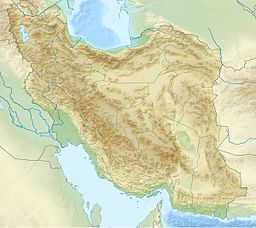Urmia
| Urmia (اروميه) | |
| Orumiyeh, Urumiah azerbajdzjanska: اورمیه, Urmiye kurdiska: ورمێ, Wurmê, Urmiye | |
| Stad | |
(c) ✿ Vlinder ✿, CC BY 3.0 | |
| Land | |
|---|---|
| Provins | Västazarbaijan |
| Shahrestan | Urmia |
| Koordinater | 37°32′38″N 45°03′52″Ö / 37.54389°N 45.06444°Ö |
| Folkmängd | 736 224 (24 september 2016)[1] |
| Geonames | 121801 |
Urmias läge på karta över Iran. | |
Urmia, eller Orumiyeh (persiska: اُرومیّه;uttal ), är en stad vid Urmiasjön i nordvästra Iran. Den är administrativ huvudort för delprovinsen Urmia och för provinsen Västazarbaijan och hade cirka 740 000 invånare vid folkräkningen 2016. Urmia hette förr Rezaiyeh. Stadens befolkning består i huvudsak av kurder och azerer.[källa behövs] I staden talas persiska, azeri och kurdiska.[källa behövs]
Urmia ligger 596 km nordväst om Teheran och 17 km från den västra stranden av sjön Urmia, söder om Khoy och Salmas, och norr om Naghadeh och Piranshahr.[2]
Källor
- ^ www.amar.org.ir; Resultat från folkräkningen i Iran 2016 Läst 28 december 2017.
- ^ ارومیه، شهر, ویکیجو, wikijoo. (persiska)
Externa länkar
 Wikimedia Commons har media som rör Urmia.
Wikimedia Commons har media som rör Urmia.
Media som används på denna webbplats
Flag of Iran. The tricolor flag was introduced in 1906, but after the Islamic Revolution of 1979 the Arabic words 'Allahu akbar' ('God is great'), written in the Kufic script of the Qur'an and repeated 22 times, were added to the red and green strips where they border the white central strip and in the middle is the emblem of Iran (which is a stylized Persian alphabet of the Arabic word Allah ("God")).
The official ISIRI standard (translation at FotW) gives two slightly different methods of construction for the flag: a compass-and-straightedge construction used for File:Flag of Iran (official).svg, and a "simplified" construction sheet with rational numbers used for this file.
Författare/Upphovsman: Uwe Dedering, Licens: CC BY-SA 3.0
Topographic map of the Iranian plateau in Central Asia, connecting to Anatolia in the west and Hindu Kush and Himalaya in the east.
Shiny red button/marker widget. Used to mark the location of something such as a tourist attraction.
Författare/Upphovsman: Mårten Mellberg, Licens: CC BY-SA 4.0
Uttal av staden Urumia på persiska





